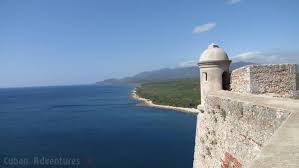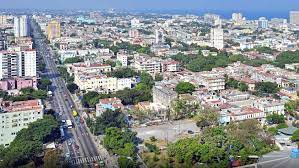SANTIAGO DE CUBA, “CAPITAL DEL CARIBE”, CUNA DE TROVADORES. VIDEOS
«Capital de la Música» también le llaman a Santiago de Cuba y razones hay muchas: cuna de géneros como la trova y de músicos como Compay Segundo, Ñico Saquito y Miguel Matamoros , y aunque lugares como la Casa de la Trova, sin dudas reverencian el pasado sonoro, hay quienes extrañan cuando las más dulces melodías brotaban en la calle cual si fueran piropos.
Sin embargo, creo que nadie es más jovial y parrandero que el santiaguero, pueblo orgulloso de su ciudad, de su historia y su cultura, adicto al café y tomador por excelencia, un poco violento a la hora de hablar y gesticular, pero igual muy sincero, muy religioso –en su más amplio sentido–, y siempre dado a la conversación y a charlar de su cotidianidad.
VISITANDO A SANTIAGO DE CUBA
El calor es el primer saludo que le ofrece la ciudad de Santiago de Cuba, un vaho de aire enrarecido que el ventilador no logra disipar.
Muchos títulos, frases, apodos… tiene la ciudad de Santiago de Cuba, pero pocos la describen tan bien como “Capital del Caribe”.
Para lo más común de los santiagueros es la de moverse en una ciudad de medio milenio, de calles zigzagueante, onduladas y con pendientes que hacen dudar hasta un atleta, aunque le aportan una singularidad espectacular a la urbe. Aquí los santos ayudan a bajar, como en cualquier lugar, pero para arriba, ni el panteón yoruba completo empinan el coraje.
Dicen que las escalinatas fueron una solución técnica a lo abrupto de la topografía, para ayudar a los transeúntes, otros aseguran que fue una estrategia defensiva para evitar el desplazamiento de la artillería pesada de los invasores por las arterias citadinas en la época colonial. Yo prefiero creer que son uno de los tantos detalles que hacen única a la urbe, evidencia del diálogo entre las personas que han vivido aquí por cinco siglos y lo escarpado del relieve. Ahí está Padre Pico, sin dudas la más famosa, pero no la única.
Es Santiago de Cuba una ciudad edificada en terrazas, en niveles, y laberíntica, hasta el que la conoce como su palma de la mano se ha sorprendido en algún giro inesperado de sus calles, en algún callejón o recoveco pintoresco.
EJEMPLOS SINGULARES DE SANTIAGO DE CUBA
Pero esa misma condición le aporta paisajes que desafían la imaginación, desde el Cobre, el del Cementerio, cualquier ambiente urbano, y sus increíbles desniveles: por eso es una ciudad paisaje, mirador y anfiteatro, que creció en perenne diálogo con el terreno y confinada entre el mar y las montañas.
Completan el fresco las montañas de las cordilleras de El Cobre, Boniato y la Gran Piedra que dominan una parte del entramado urbano y sirven de cierre visual de muchas de sus calles, un hermoso trasfondo, verde intenso casi todo el año, y donde se pueden encontrar algunos de los vestigios más importantes del patrimonio cafetalero, considerado Patrimonio de la Humanidad.
En el otro extremo el mar, una profunda bahía de bolsa, de aguas oscuras y tranquilas, que aporta el sentido marinero a la ciudad, matices que hoy se redescubren porque el santiaguero vuelve a mirar a su rada y se reconcilia con ella. ¡Menos mal!
La Fortaleza de San Pedro de la Roca, nuestro Morro, domina, como nadie, el paisaje costero de Santiago de Cuba. Imponente, majestuoso, prístino…
Ese sabor se siente en la manera de vestir, en el calor de la gente, en el mestizaje, en las tradiciones, en la forma de hablar, de pregonar, un acervo cultural que tiene cúspides como la Tumba Francesa (Obra Oral e Inmaterial de la Humanidad), las congas, los carnavales (Patrimonio Cultural de la Nación), la Fiesta del Fuego…
El santiaguero, en algunas cuadras, vive más de la puerta para fuera que en el interior del hogar, siempre con la cafetera lista, igual que las chancletas para correr y meterse en la conga o presenciar cualquier pelea en el barrio.
Vivimos hacia fuera, intensamente, hablamos bien alto, gritando, y reímos más alto aún, y siempre con una ocurrencia, con una picardía y un chiste clamando salir y hacer la delicia de los amigos y vecinos. El santiaguero siempre ríe, por muy mala que esté la cosa.
Es una locura intentar resumir aquello que identifica o resulta singular en la ciudad de Santiago de Cuba. Mientras que a otras quizás le falten atractivos, a la «tierra caliente» le sobran. Desde sus calles, cual serpentinas que coquetean o danzan con el terreno, hasta sus edificaciones, sus tres componentes del patrimonio de la humanidad e historia desparramada por doquier, aquí todo parece haber sido bendecido.
Somos, sin lugar a dudas, santiagueros, el término es casi un adjetivo, no hay otra forma de resumirlo.
SANTIAGO DE CUBA, “CAPITAL OF THE CARIBBEAN”, CRADLE OF TROUBADOURS. VIDEOS
Santiago de Cuba is also called “Capital of Music” and there are many reasons: the cradle of genres such as trova and musicians such as Compay Segundo, Ñico Saquito and Miguel Matamoros, and although places like the Casa de la Trova undoubtedly revere the sound past, there are those who miss when the sweetest melodies sprouted in the street as if they were compliments.
However, I believe that nobody is more jovial and a party person than the people of Santiago, a people who are proud of their city, their history and their culture, addicted to coffee and drinker par excellence, a little violent when it comes to speaking and gesturing, but still very sincere, very religious -in its broadest sense-, and always given to conversation and chatting about his daily life.
VISITING SANTIAGO DE CUBA
The heat is the first greeting that the city of Santiago de Cuba offers you, a rarefied vapor of air that the fan cannot dissipate.
The city of Santiago de Cuba has many titles, phrases, nicknames… but few describe it as well as “Capital of the Caribbean”.
For the most common of the people of Santiago it is to move in a city of half a millennium, with zigzag streets, undulating and with slopes that make even an athlete doubt, although they provide a spectacular uniqueness to the city. Here the saints help to go down, as in any other place, but up, not even the complete Yoruba pantheon raise their courage.
They say that the stairways were a technical solution to the abruptness of the topography, to help passers-by, others say that it was a defensive strategy to prevent the displacement of the invaders’ heavy artillery through the city’s arteries in colonial times. I prefer to believe that they are one of the many details that make the city unique, evidence of the dialogue between the people who have lived here for five centuries and the steepness of the relief. There is Padre Pico, undoubtedly the most famous, but not the only one.
Santiago de Cuba is a city built on terraces, levels, and labyrinthine, even those who know it like the palm of their hand have been surprised at some unexpected turn in its streets, in some picturesque alley or nook.
SINGULAR EXAMPLES FROM SANTIAGO DE CUBA
But that same condition provides it with landscapes that defy the imagination, from El Cobre, the Cemetery, any urban environment, and its incredible unevenness: that is why it is a landscape city, viewpoint and amphitheatre, which grew in perennial dialogue with the terrain and confined between the sea and the mountains.
The coolness is completed by the mountains of the El Cobre, Boniato and Gran Piedra mountain ranges, which dominate a part of the urban fabric and serve as a visual closure for many of its streets, a beautiful background, intense green almost all year round, and where you can find some of the most important vestiges of the coffee heritage, considered a World Heritage Site.
At the other end, the sea, a deep pocket bay, with dark and calm waters, which brings a sense of the sea to the city, nuances that are rediscovered today because the people of Santiago look back at their harbor and reconcile with it. Goodness!
The Fortress of San Pedro de la Roca, our Morro, dominates, like nobody else, the coastal landscape of Santiago de Cuba. Imposing, majestic, pristine…
That flavor is felt in the way of dressing, in the warmth of the people, in the miscegenation, in the traditions, in the way of speaking, of preaching, a cultural heritage that has peaks such as the French Tomb (Oral and Intangible Work of Humanity), the congas, the carnivals (Cultural Heritage of the Nation), the Fiesta del Fuego…
The people of Santiago, in some blocks, live more from the door to the outside than inside the home, always with the coffee maker ready, just like the flip-flops to run and get into the conga or witness any fight in the neighborhood.
We live outside, intensely, we talk loudly, shouting, and we laugh even louder, and always with an occurrence, with a mischief and a joke crying out to go out and delight our friends and neighbors. The man from Santiago always laughs, no matter how bad things are.
It is crazy to try to summarize what identifies or is unique in the city of Santiago de Cuba. While others may lack attractions, the “hot land” has plenty. From its streets, like serpentines that flirt or dance with the terrain, to its buildings, its three components of the World Heritage Site and history scattered everywhere, everything here seems to have been blessed.
We are, without a doubt, from Santiago, the term is almost an adjective, there is no other way to summarize it.
Agencies/ Wiki/ CiberCuba/ José R.Loo/ Extractos/ Excerpts/ Internet Photos/ Arnoldo Varona/ www.TheCubanHistory.com
THE CUBAN HISTORY, HOLLYWOOD.












